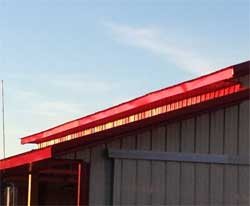If you are like me, you looked at this photo and the first thought was – the trim on the upper roof looks…..well frankly bad.
 Well it is bad, and it is bad due to installation issues, which could easily have been avoided.
Well it is bad, and it is bad due to installation issues, which could easily have been avoided.
1. The first trick to getting a good looking fascia, is to pick straight boards. The Hansen Pole Buildings Installation Manual even encourages setting aside the straightest boards to use for fascia boards.
2. Make sure the fascia boards are installed straight (as in up and down straight), as well as in and out straight. It is all too easy for the heights of truss or rafter tails to be up or down by even fractions of an inch. Start getting one end up, next end down and repeat the process a few times (even if by only 1/8th of an inch) and things can get messy. Ideally, attach the fascia boards to the truss or rafter tails by use of a tight stringline.
3. Fascia trims are best installed when they are warm, as installing them when cold can lead to oil canning on very hot days. (Oil canning is when a flat sheet of steel gets ripples in it.) A 10 foot long piece of steel trim will change in length by 0.120” in a 150 degree F. temperature swing. Although this is small, it does exist and should be taken into account.
4. Fascia trims are designed to abut each other, not overlap. Behind each joint, place a bead of caulking (color matched caulking is available), so as to insure a weather tight joint.
5. Install fascia trims to a stringline across the bottom edge, any ups and downs between the top of the fascia board and the roof steel will be hidden by the shadow of the roofing. Fasteners should be placed within a few inches of each end of the piece of trim and approximately every three feet along the length. If fastening upwards into the bottom of the fascia board, drive fasteners only in far enough to align the trim with the stringline. Any screws installed through the wide face of the fascia trim should be in a straight line and close to the top edge of the trim. Do not over-tighten screws. They are best left slightly on the loose side to prevent puckers.
With a little patience, fascia trims can not only be straight and stay straight, but most important of all – look straight on hot or cold days!






